Terry L. Ettinger Horticulture Consulting Services
Meeting The Needs Of Today With A Vision For The Future
Question of the Week
Containers and Potting Soils
Q. I moved into a nice duplex that has a good-sized, south-facing deck this past spring. Because of all the sun, I thought the deck would be a great place to grow all sorts of plants in containers. Unfortunately, few plants have grown well and I'm very discouraged. Any suggestions you might have would be appreciated.
A. Without more information about the plants you've tried to grow, the size of containers, the type of potting soil, etc., I can't offer any specific answers to your question. I can, however, offer some general rules of thumb that should be helpful to anyone growing plants in containers.
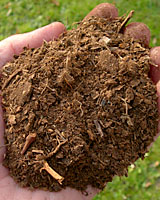 First, it's very important to use potting soils that consists of
75% to 85% sphagnum peat moss, at left - not sedge peat, not
hypnum peat, and not compost or forest products.
First, it's very important to use potting soils that consists of
75% to 85% sphagnum peat moss, at left - not sedge peat, not
hypnum peat, and not compost or forest products.
Sphagnum peat moss consists of recognizable bits of leaves and stems. Because it's not significantly decomposed, about 25% of its volume immediately fills with air as it drains while 50% of its volume is water that's held in a form that's readily available to plant roots (the remaining 25% of its volume is the peat moss itself).
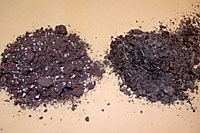 Sphagnum pest moss potting soils
(the pile at left in the picture at right) are lighter brown in color than
those made out of the other peats and/or composted products, much
lighter in weight, and they're "spongy" when squeezed, instead of
sticking together in a clod.
Sphagnum pest moss potting soils
(the pile at left in the picture at right) are lighter brown in color than
those made out of the other peats and/or composted products, much
lighter in weight, and they're "spongy" when squeezed, instead of
sticking together in a clod.
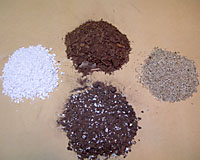 While I've used Premier Horticulture's
PRO-MIX "BX" for many years, several other products are of equal quality including Jiffy-Mix,
Sun-Gro Sunshine mixes, etc. The primary ingredient in all of these
potting soils is - yup, you guessed it - sphagnum peat moss, along
with horticultural-grade perlite and vermiculite.
While I've used Premier Horticulture's
PRO-MIX "BX" for many years, several other products are of equal quality including Jiffy-Mix,
Sun-Gro Sunshine mixes, etc. The primary ingredient in all of these
potting soils is - yup, you guessed it - sphagnum peat moss, along
with horticultural-grade perlite and vermiculite.
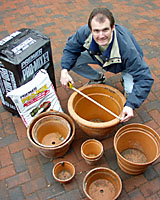 Next, big containers are good, bigger containers are better, and the biggest containers are best as we move through the
growing season.
Next, big containers are good, bigger containers are better, and the biggest containers are best as we move through the
growing season.
As plants grow larger over the summer and temperatures soar into the 80's and 90's, the soil in small containers can go from sopping wet to almost bone dry within a matter of hours. This wide fluctuation in soil moisture is very hard on plants and is often a primary contributor to their decline as the summer progresses.
The best way to combat this potentially daily swing in soil moisture levels is to provide plenty of soil for your plants to grow in. Large volumes of peatmoss-based potting soil can hold enough water to get most container plantings through at least an entire day. Moist soil also protects plant roots from excessively high high soil temperatures - which can be as damaging to the root systems of some plants as is a lack of water.
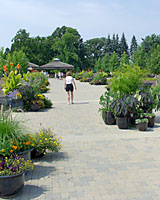 One of the very best places to see stunning plantings of annuals and
tender perennials in large containers and hanging baskets is at the
Niagara Parks Botanical Gardens and School of Horticulture in
Niagara Falls, Canada, at left.
One of the very best places to see stunning plantings of annuals and
tender perennials in large containers and hanging baskets is at the
Niagara Parks Botanical Gardens and School of Horticulture in
Niagara Falls, Canada, at left.
Finally, in some situations, such as on your apartment balcony perhaps, it may not be practical to use over-sized containers. If space is a limitation, in addition to using a peatmoss-based potting soil, grow plants that can tolerate potentially very dry soil conditions for at least a short period of time. A brief list of such plants includes annual fountaingrass, lantana, Joseph's coat, summer snapdragon, melampodium, nierembergia, pentas, Texas sage, creeping zinnia and tithonia.